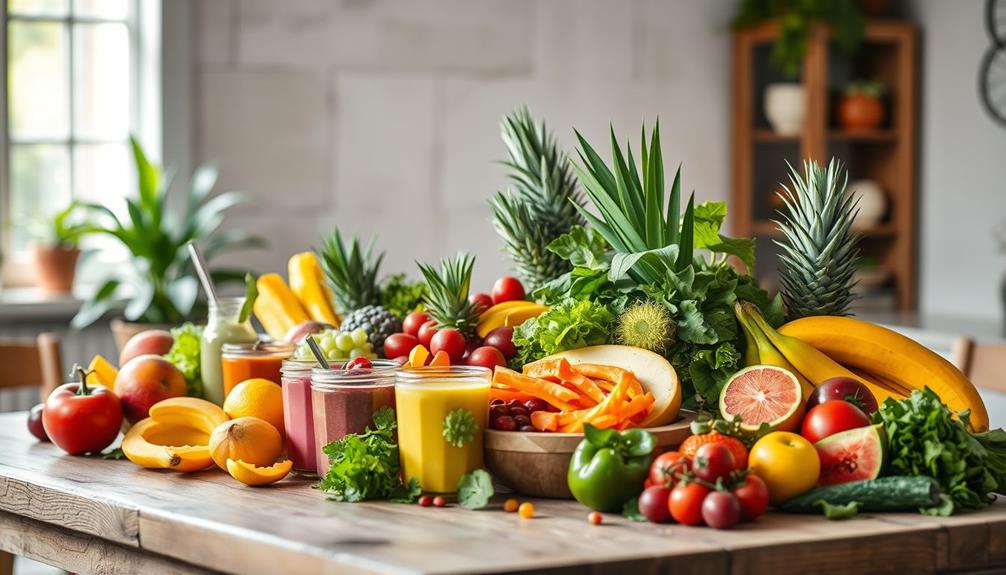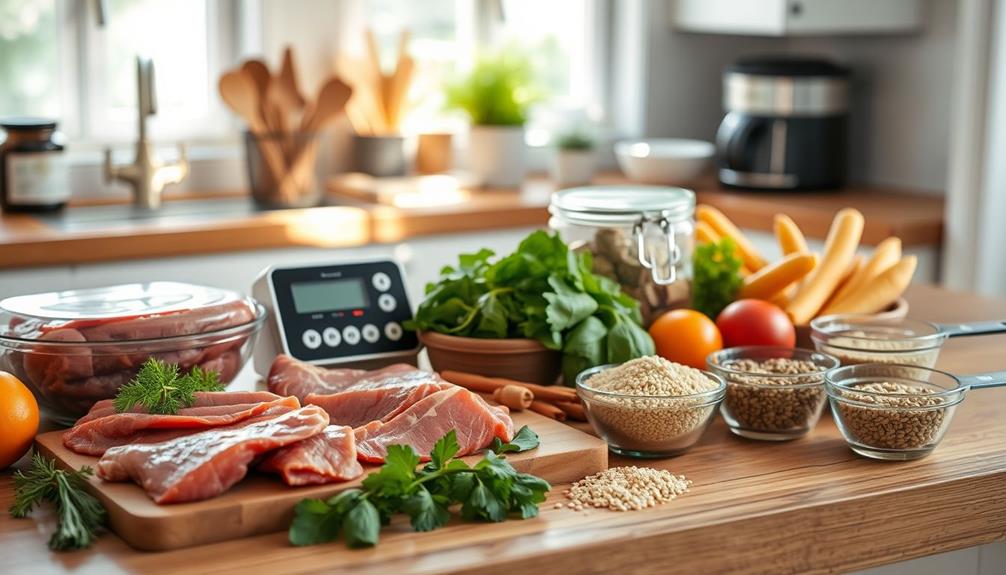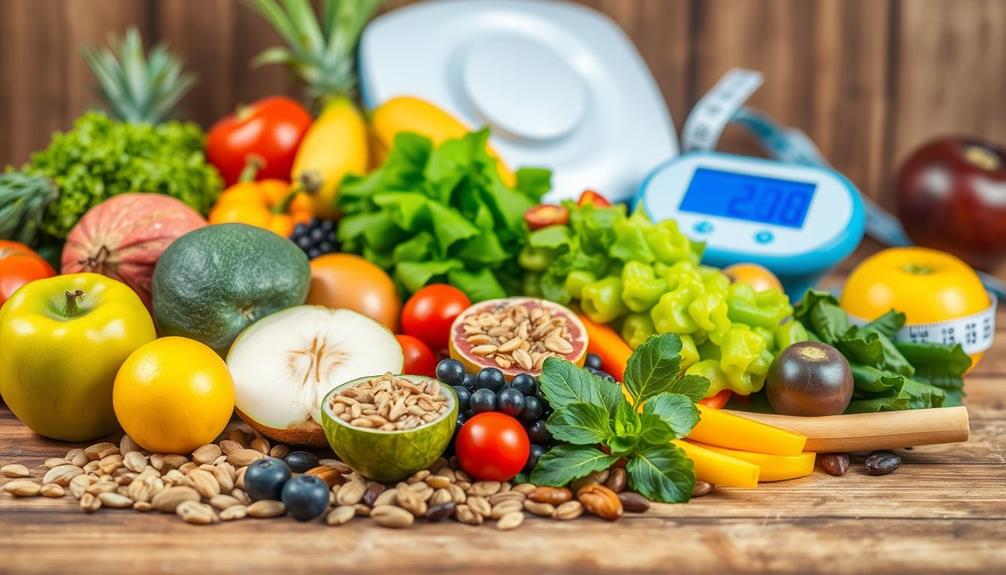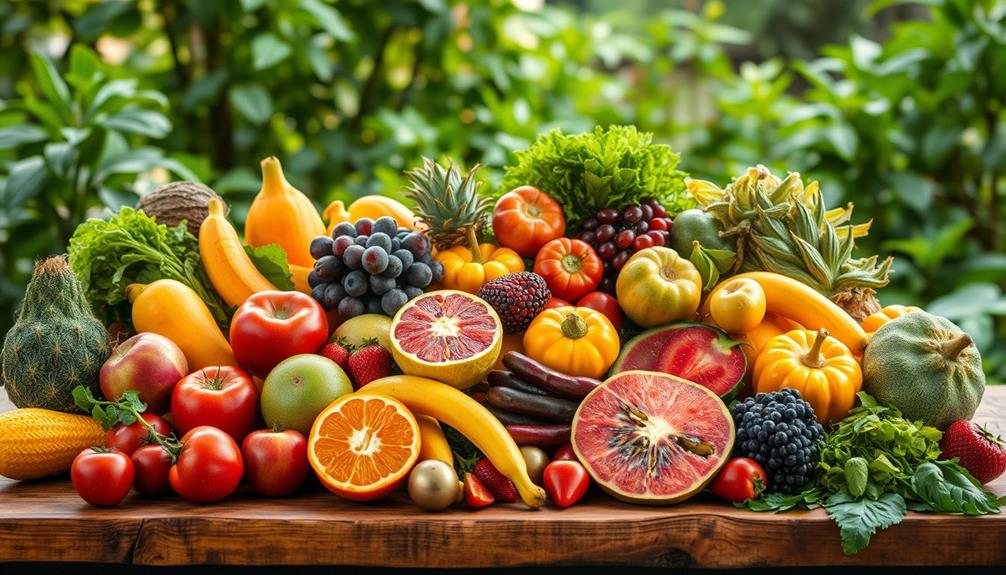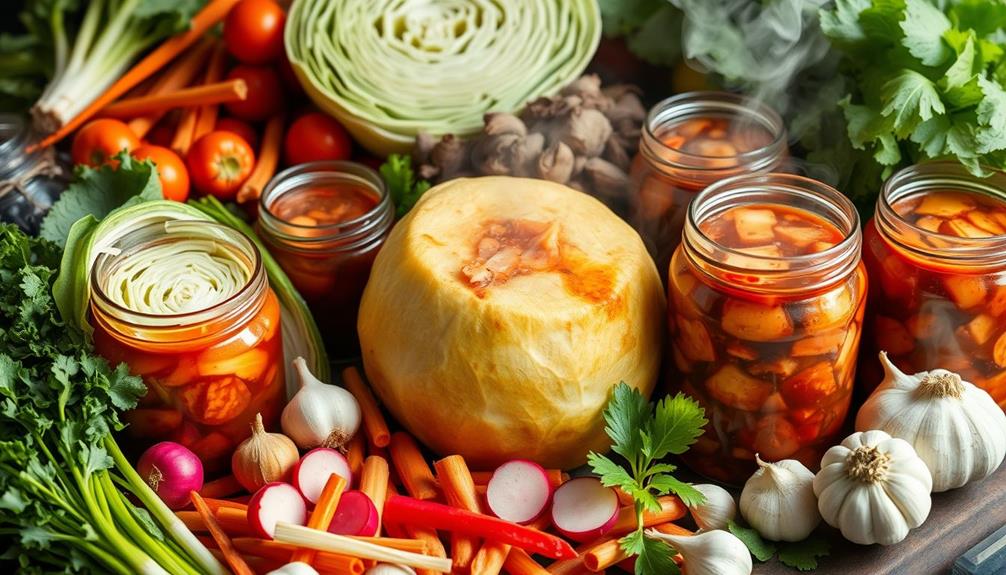To make raw food, start by stocking your kitchen with fresh fruits, vegetables, nuts, and seeds. Emphasize whole, unprocessed ingredients, and try techniques like soaking, sprouting, and dehydrating for tasty results. Use a high-quality blender or food processor for smooth textures in recipes like raw vegan pizza or avocado chocolate pudding. Don't forget to experiment with flavors, incorporating herbs and spices to elevate your dishes. Keep portion sizes in check, especially with calorie-dense nuts. If you're enthusiastic to explore more recipes and tips, keep going to discover even more exciting raw food options! Raw food diet tips can help you stay on track and maintain a balanced, nutritious diet. Be sure to incorporate a variety of colors and textures to keep your meals interesting and satisfying. Also, be mindful of food safety when dealing with raw ingredients, and consider investing in a good set of knives and kitchen tools to make meal preparation easier and more enjoyable. With these raw food diet tips in mind, you’ll be well on your way to enjoying the health benefits and delicious flavors of raw food cooking.
Key Takeaways
- Stock your kitchen with staples like fresh produce, nuts, seeds, and dried fruits for versatile meal options.
- Use a high-quality blender and food processor for easy preparation of smoothies, dips, and desserts.
- Incorporate soaking and sprouting techniques to enhance digestibility and nutrient absorption in nuts and seeds.
- Experiment with popular raw recipes like vegan pizza, salads, and desserts to add variety to your meals.
- Join online communities for tips, recipe sharing, and support in your raw food journey.
Understanding Raw Food
Understanding raw food starts with recognizing its core principle: food prepared at temperatures below 118°F (48°C) retains essential enzymes and nutrients that cooking can destroy. This approach is fundamental to the raw vegan diet, which emphasizes whole, unprocessed foods.
By focusing on healthy ingredients like fresh fruits and vegetables, you'll not only enhance your meals but also effortlessly meet your daily produce intake. Additionally, a raw food diet can support digestive health with high water content and fiber, contributing to overall wellness boosts immune system function due to high vitamin and antioxidant levels.
Common preparation techniques for raw food include dehydrating, soaking, sprouting, and low-temperature cooking. These methods elevate flavors and textures while preserving nutritional value.
Engaging with local farmers to source seasonal produce can spark creativity and variety in your raw food recipes, making each meal an exciting experience.
Health Benefits of Raw Diet
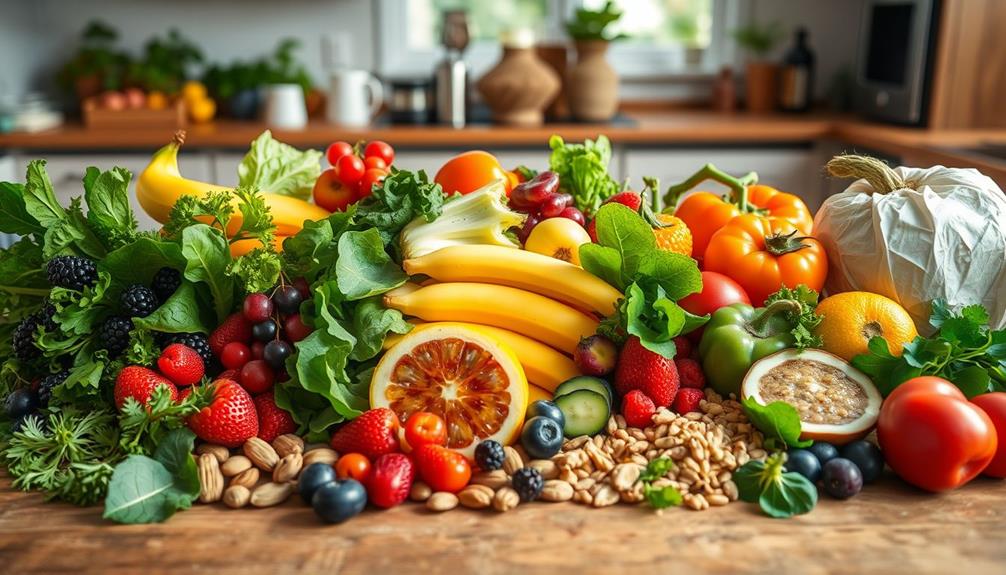
Eating a raw food diet helps you retain essential nutrients and enzymes that cooking often destroys, boosting your digestion and overall health.
Additionally, this approach can align with effective strategies for weight loss by emphasizing whole, unprocessed foods.
Plus, the high fiber content in raw fruits and vegetables can help stabilize your blood sugar levels, which is especially beneficial if you have diabetes.
Embracing raw foods can lead to a healthier, more balanced lifestyle.
Nutrient Retention Benefits
Raw food diets pack a powerful punch when it comes to nutrient retention, allowing you to keep the enzymes and essential nutrients that cooking often strips away. By focusing on raw foods, you can enjoy a wealth of health benefits, including improved digestion and enhanced energy levels.
Additionally, incorporating antioxidant-rich foods like cranberry juice can further support your overall health. Here are four key benefits of nutrient retention in a raw vegan diet:
- Preserved Nutrients: Raw foods retain vitamins, minerals, and antioxidants, essential for maintaining peak health.
- Better Digestion: The high fiber content in raw fruits and vegetables promotes gut health and aids digestion.
- Increased Energy: Whole, unprocessed foods provide natural energy sources, helping you feel more vibrant throughout the day.
- Immune Support: Antioxidants found in raw foods strengthen your immune system and may lower the risk of chronic diseases.
You'll find many of these ingredients at health food stores, making it easy to incorporate them into your daily meals.
Blood Sugar Control
Balancing blood sugar levels is essential for maintaining overall health, and a raw vegan diet offers a delicious way to achieve this. A raw food diet is loaded with whole fruits, vegetables, and leafy greens, all rich in fiber, which helps stabilize blood sugar levels and improves insulin sensitivity. This is particularly beneficial if you're a Type 2 diabetic.
The natural sugars in raw fruits are metabolized differently than refined sugars, potentially reducing insulin dependency. By incorporating raw foods, you can considerably reduce glycemic load, which is critical for effective blood sugar management. Plus, essential nutrients like magnesium and calcium found in raw plant foods play a fundamental role in regulating blood sugar.
Here's a quick look at some raw vegan recipes that can help you control blood sugar:
| Recipe | Key Ingredients | Benefits |
|---|---|---|
| Green Smoothie | Spinach, banana, chia | High in fiber, low glycemic |
| Zucchini Pasta | Zucchini, tomatoes | Low carb, rich in nutrients |
| Raw Energy Balls | Dates, nuts, cacao | Natural sugars, great for energy |
Incorporating these raw vegan recipes into your diet can aid in detoxification, further enhancing blood sugar control.
Essential Preparation Tips
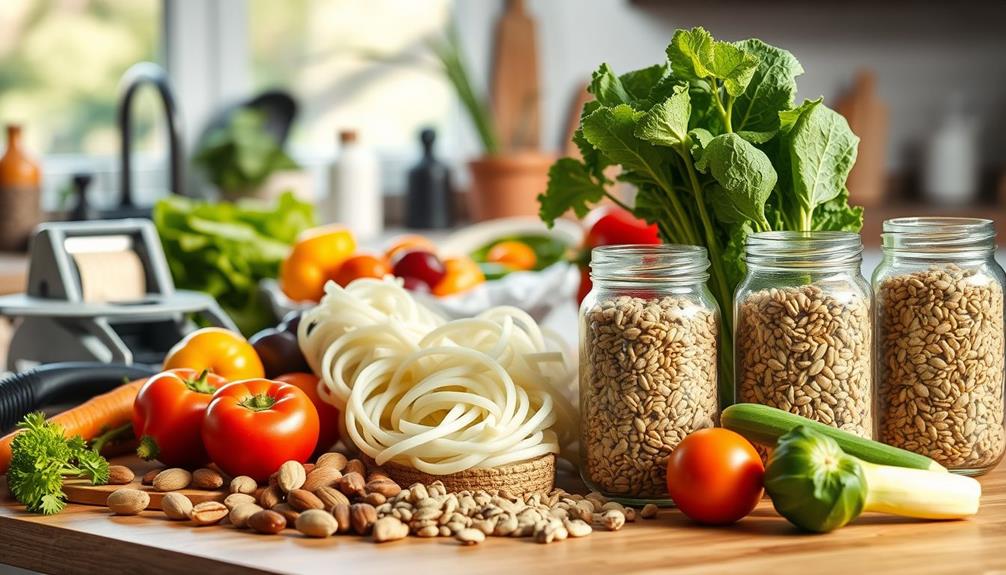
To successfully prepare raw food meals, you'll often want to start by stocking your kitchen with essential ingredients. This guarantees you have everything on hand to make raw food effortlessly. Here are some staples to take into account:
- Flax seeds and chia seeds – Great for adding fiber and omega-3 fatty acids, which can aid in reducing inflammation and may support overall health, similar to how herbal teas can alleviate pain.
- Variety of fresh fruits and vegetables – They'll provide the base for your raw meals and add vibrant flavors.
- Nuts and seeds – Soak them overnight for better digestibility and quicker preparation.
- High-quality blender and food processor – These tools are vital for creating smooth blends or finely chopping ingredients.
Additionally, don't forget to experiment with flavor enhancement techniques, like massaging greens with olive oil and salt, to elevate their taste.
Always read recipes thoroughly to grasp preparation times and techniques. Keeping it simple at first will help you build confidence in your raw food preparation skills.
Popular Raw Food Recipes
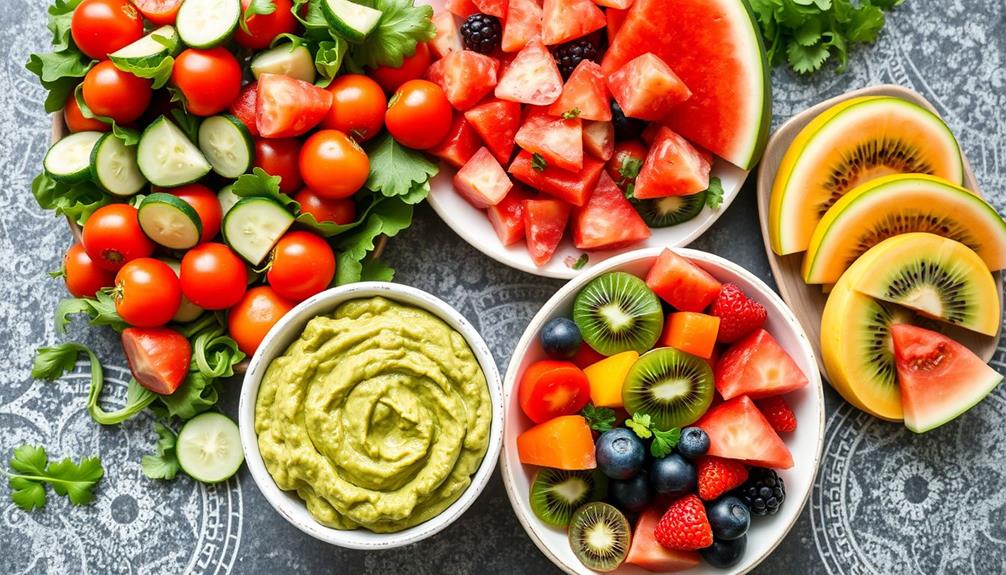
Exploring popular raw food recipes opens up a world of delicious and nutritious meals that are easy to prepare. One standout option is a raw vegan pizza featuring a nut-based crust topped with fresh vegetables. It's a creative twist on traditional pizza that packs a nutritious punch.
For those with a sweet tooth, raw desserts like chocolate pudding made from avocado or raw brownies offer guilt-free indulgence. Incorporating fresh ingredients also supports overall wellness, similar to how essential oils can enhance health through natural remedies.
Don't forget raw vegan salads, such as Kale Salad and Fennel Orange Salad, which emphasize fresh ingredients and can serve as satisfying main dishes or sides. These salads enhance your vegetable intake while bursting with flavor.
For something versatile, try dips and spreads like guacamole or sundried tomato pesto. They pair perfectly with fresh vegetables or raw crackers, making them ideal for snacking.
If you're up for unique main dishes, consider raw vegan lasagne or raw pasta puttanesca. These dishes showcase the incredible variety of textures and flavors achievable in raw cuisine.
Community and Resource Sharing

Connecting with others who share your passion for raw food can make your journey much more enjoyable and enriching. Engaging with an active community provides valuable support and resources that can help you thrive as a beginner.
Additionally, exploring top platforms for earning money online can help you fund your raw food adventures. Here are some ways to tap into this vibrant network:
- Join Online Platforms: Participate in social media groups and forums dedicated to raw food. You'll find a wealth of recipes, tips, and personal experiences shared by fellow enthusiasts.
- Explore Blogs and Courses: Many blogs offer access to raw food courses and free recipes, perfect for beginners looking to experiment with new techniques and flavors.
- Subscribe to Newsletters: Get exclusive content by signing up for newsletters. You might receive PDFs with top raw recipes that can enhance your meal planning.
- Engage with the Community: Use user comments to ask questions or share your own variations on recipes. This interaction fosters a supportive atmosphere, where everyone learns from each other.
Challenges of Raw Food Diet
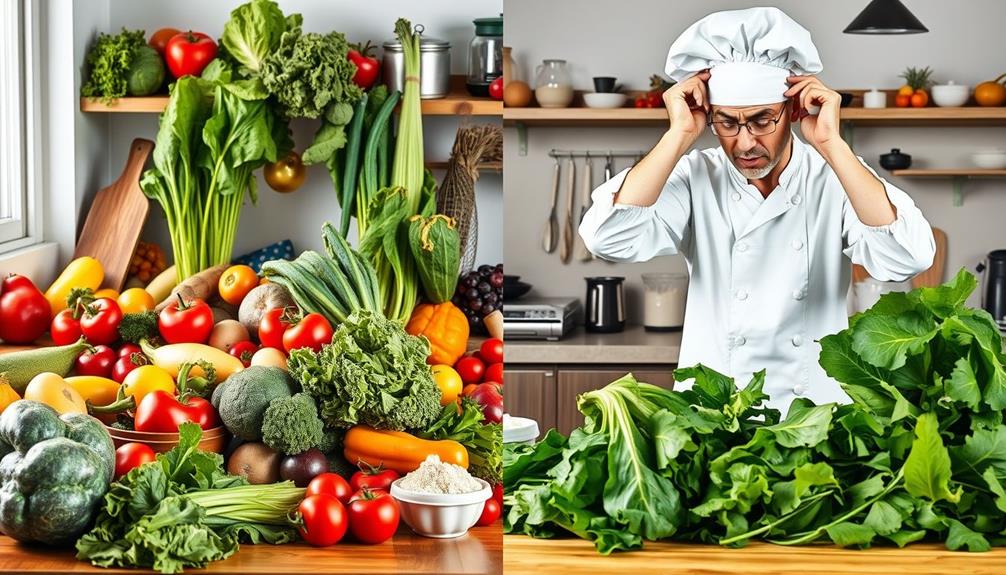
When you switch to a raw food diet, you might face some challenges like nutrient deficiencies, especially in calcium and vitamin D.
It's important to evaluate nutritional balance to guarantee you're meeting all your dietary needs.
It's also vital to monitor your blood sugar levels, as natural sugars from fruits can affect your body differently than refined sugars.
Plus, be mindful of portion sizes, since overindulging in high-calorie raw foods like nuts and seeds can lead to weight management concerns.
Nutrient Deficiencies Risks
How can a raw food diet impact your nutrient intake? While a raw food diet can be vibrant and healthy, it's important to be aware of potential nutrient deficiencies. If you're not careful, you might miss out on necessary nutrients that your body needs.
For instance, key domains of development highlight the importance of a balanced diet for overall growth and well-being. Here are some key areas to watch:
- Calcium and Vitamin D: These are essential for bone health and may be lacking in a strict raw vegan diet.
- Vitamin B12: This nutrient, crucial for energy metabolism, is typically found in animal products; vegans must find alternative sources.
- Protein Needs: Raw fruits and vegetables often contain lower protein levels, so you'll need to plan carefully to meet your daily protein requirements.
- Omega-3 Fatty Acids: These important fats are usually found in fish and fortified foods, which aren't included in a raw diet.
To avoid these risks, it's fundamental to incorporate a variety of raw foods and engage in careful planning. Doing so will help guarantee you're getting the necessary nutrients your body requires to thrive on a raw food diet.
Blood Sugar Monitoring
Monitoring blood sugar levels is essential for anyone, especially those with diabetes, as they shift to a raw food diet. The high fiber content found in raw fruits and vegetables can greatly impact your blood sugar levels, helping to stabilize them compared to refined sugars. However, it's important to understand how different foods affect your glucose levels.
| Food Type | Potential Impact on Blood Sugar | Fiber Content |
|---|---|---|
| Whole Fruits | Moderate increase | High |
| Leafy Greens | Minimal increase | Very High |
| Dried Fruits | Notable increase | Moderate to Low |
Regularly tracking your blood sugar before and after meals will help you pinpoint how various raw foods impact your levels. A raw vegan diet might even reduce insulin dependency for some, as natural sugars are metabolized more slowly. Remember, consulting with healthcare professionals is essential to guarantee your raw food diet meets your dietary needs and to monitor for any potential nutrient deficiencies. This proactive approach will help you maintain healthy blood sugar levels while enjoying your raw food journey.
Weight Management Concerns
Shifting to a raw food diet can be a double-edged sword for weight management. While you might initially lose weight due to lower calorie intake from high-water-content foods, it's vital to plan carefully to avoid nutrient deficiencies.
Understanding your body's response to different foods is fundamental, especially when considering common financial terms and jargon that can impact your budgeting for healthy eating.
On the flip side, you could gain weight if you consume too many high-calorie raw foods, like nuts and seeds. To help you navigate this, consider these tips:
- Monitor Portion Sizes: Keep an eye on how much you eat, especially with calorie-dense foods.
- Balance Your Intake: Aim for a balanced intake of fruits, vegetables, nuts, and seeds to guarantee you get all essential nutrients.
- Stay Mindful of Calorie Sources: Focus on low-calorie options to maintain your energy levels without overdoing it.
- Consult Professionals: Reach out to healthcare professionals for personalized dietary advice tailored to your weight management goals.
Frequently Asked Questions
How Do You Prepare Raw Food?
To prepare raw food, you'll soak, sprout, blend, and dehydrate ingredients. Focus on fresh fruits and vegetables, massage greens with olive oil, and organize your kitchen for quick, nutritious meals. Enjoy the vibrant flavors!
How to Make Your Own Raw Food for Your Dog?
Like a chef crafting a gourmet meal, you can create your dog's raw food by mixing fresh fruits, vegetables, and proteins. Just remember to avoid toxic ingredients and consult your vet for balanced nutrition. Enjoy!
What Are the Techniques of Raw Food?
When exploring raw food techniques, you'll find dehydrating preserves nutrients, soaking enhances digestibility, sprouting boosts nutrition, blending creates smooth textures, fermenting adds probiotics, and honing knife skills elevates flavor and presentation in your dishes.
What Are the Rules for Raw Food?
Did you know that cooking can destroy up to 50% of nutrients? To enjoy raw food, keep temperatures below 118°F, use fresh, organic ingredients, and store meals in airtight containers for peak freshness.
Conclusion
By embracing a raw food diet, you're not just nourishing your body but also making a positive impact on the planet. Did you know that if everyone in the U.S. replaced just one meal a week with plant-based foods, it could save over 1 billion animals a year? As you explore the vibrant world of raw foods, remember that every small change counts. So, immerse yourself, get creative, and enjoy the journey to a healthier, more sustainable lifestyle!

